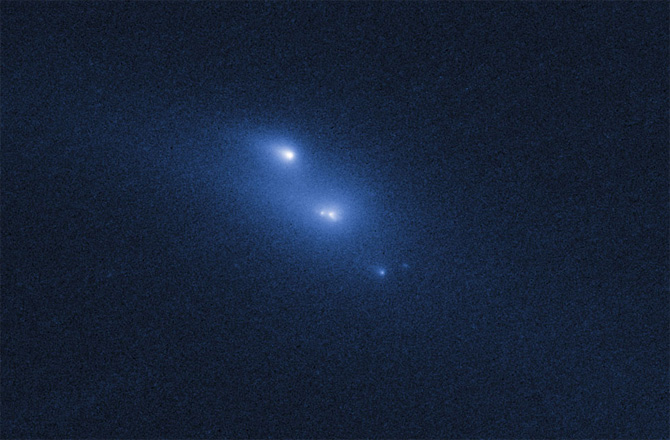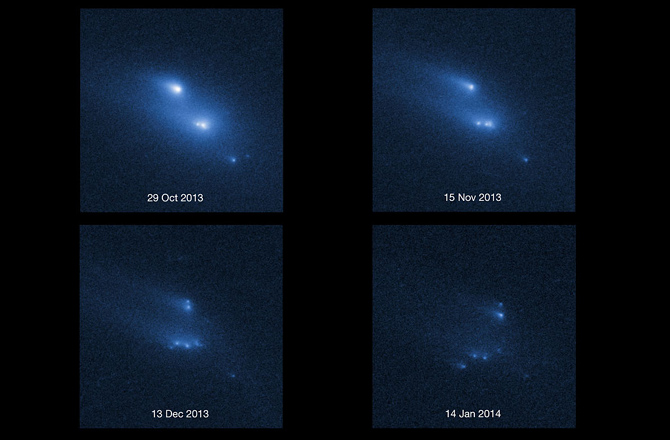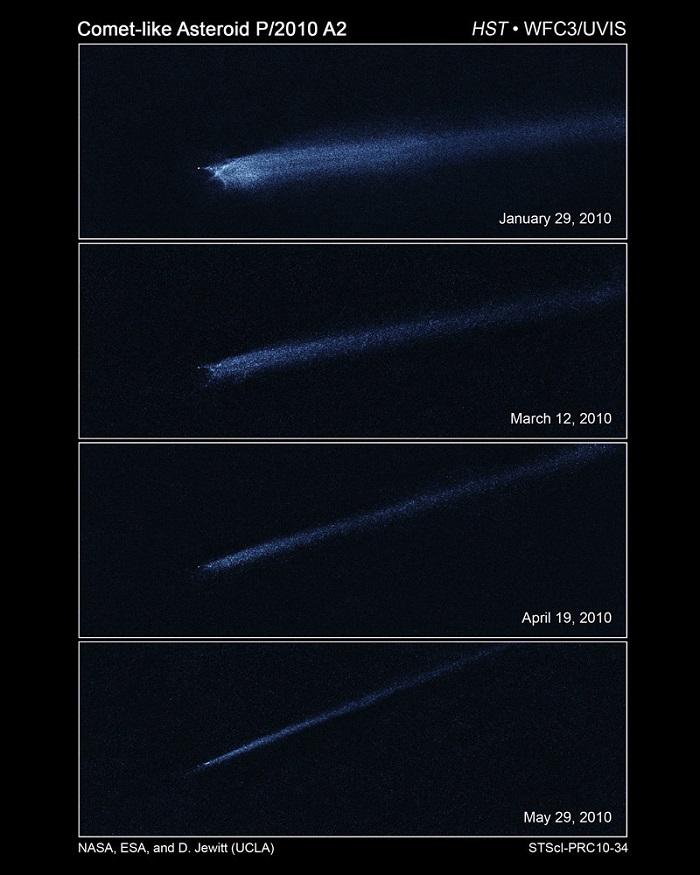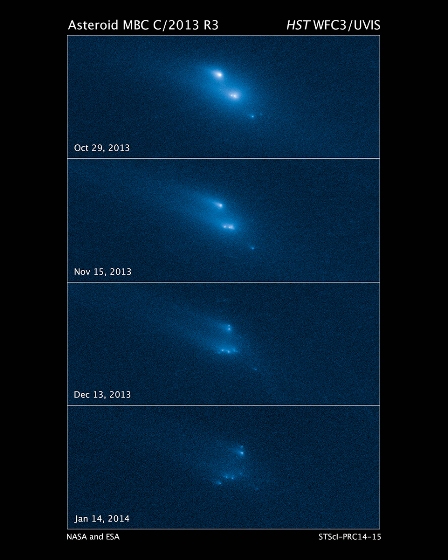.

NASA/ESA Hubble Space Telescope observation of asteroid P/2013 R3. This asteroid has been found to be disintegrating and breaking apart -- the first such body ever seen to do this. This image shows P/2013 R3 as it was seen on Oct. 29, 2013.
.
Hubble has observed some weird things since it was launched in 1990, but this is probably one of the strangest.
In September 2013, the Catalina and Pan-STARRS sky surveys spotted a mysterious object in the asteroid belt, a region of rocky debris that occupy the space between the orbits of Mars and Jupiter. Follow-up observations by the Keck Observatory in Hawaii resolved three separate objects within the fuzzy cloud. It was so strange that Hubble mission managers decided to use the space telescope to get a closer look.
And what they saw has baffled and thrilled astronomers in equal measure.
Hubble resolved the slow-moving debris of an asteroid that is in the process of breaking up. The asteroid, designated P/2013 R3, hasn’t hit anything, as the fragments are moving too slow — it just seems to be falling apart. This is unprecedented, never before has an asteroid been seen disintegrating to this degree in the asteroid belt.
“This is a rock. Seeing it fall apart before our eyes is pretty amazing,” said David Jewitt of the University of California, Los Angeles, who led the investigation.
Comets are often seen fragmenting in this way, particularly when they drift too close to the sun; ices sublimate, creating a violent out-gassing of vapor, causing the cometary structure to rupture and break apart. A recent example of a cometary breakup is that of Comet ISON that got shredded by the sun’s extreme heating and powerful tidal forces during Thanksgiving last year.
While analyzing Hubble data, Jewitt’s team could actually see ten separate chunks of asteroid slowly drifting apart — at only 1.5 kilometers per hour (the speed of a slow walk). Four of the largest chunks are around 400 meters wide, roughly four times the length of a football field.
“This is a really bizarre thing to observe — we’ve never seen anything like it before,” said co-author Jessica Agarwal of the Max Planck Institute for Solar System Research, Germany, in a Hubble news release. “The break-up could have many different causes, but the Hubble observations are detailed enough that we can actually pinpoint the process responsible.”
.

This series of images shows the asteroid P/2013 R3 breaking apart, as viewed by the NASA/ESA Hubble Space Telescope in 2013.
.
So what could possibly be causing this asteroid to just fall apart?
With the collision scenario already eliminated, could the break-up be down to ices trapped in the rock heating up and outgassing, causing fragmentation in a similar way to how comets disintegrate? This is unlikely, as there isn’t a significant heat source in the asteroid belt and the asteroid is far away from the sun.
The leading theory for the breakup of P/2013 R3 is a bizarre Yarkovsky–O’Keefe–Radzievskii–Paddack (YORP) effect. As the sun’s radiation heats up one side of a space rock, that heat is radiated away as the asteroid rotates. The infrared radiation that is emitted from the dark side of the asteroid gives the asteroid a tiny kick. Over millions of years, this tiny acceleration effect can cause the asteroid to “spin up.” Should the spinning become faster than the structure of the asteroid can hold itself together, centrifugal forces can literally rip it apart.
As many asteroids are believed to be loose collections of rocks and dust — known as “rubble piles” — the impact of the YORP effect can be pretty dramatic, as P/2013 R3 can attest.
“This is the latest in a line of weird asteroid discoveries, including the active asteroid P/2013 P5, which we found to be spouting six tails,” says Agarwal. “This indicates that the sun may play a large role in disintegrating these small solar system bodies, by putting pressure on them via sunlight.”
This recent asteroid belt oddity comes hot on the heels of another disintegrating space rock, P/2013 P5, that was observed to have very comet-like qualities. The dusty three six tails of P/2013 P5 is also strong evidence for the YORP effect causing the asteroid to spin up and eject material from its equator.
While observing the expanding mass of debris, astronomers have estimated that there are 200,000 tons of material expanding to a volume the size of Earth.
As Hubble continues to study these strange findings in the asteroid belt, we are finding that a little solar heating over thousands to millions of years can have a dramatic impact on large asteroids, once again proving that our solar system is a dynamic and fascinating place.
.
Hubble's Bizarre X-Shaped Slow-Motion Asteroid Collision

In January, something mysterious was spotted lurking in the asteroid belt between the orbits of Mars and Jupiter. The eerie comet-like feature — sporting a long tail of dust being swept back by the sun’s radiation pressure — was thought to be a rare asteroid/comet hybrid, but when the Hubble Space Telescope took a closer look, a bizarre shape formed.
An “X” pattern emerged, revealing to astronomers that they were actually looking at the site of a recent (and equally as rare) asteroid-on-asteroid collision a little over 100 million miles from Earth. The pattern was believed to be the debris of the smash expanding into space. However, all’s not what it seems.
BIG PIC: Mystery Comet or Asteroid Collision?
According to Hubble scientists that have been tracking the debris cloud (called P/2010 A2), the asteroid collision didn’t happen recently, it actually happened last year, most likely around February or March 2009.
“We thought this event had just occurred,” said David Jewitt, UCLA astronomer and lead scientist of the Hubble observation, in today’s press release. “We expected the debris field to expand dramatically, like shrapnel flying from a hand grenade.”
This chance observation by ground observatories caused a rush to get Hubble turned around and look at the event. After all, catching a once-in-a-lifetime glimpse of the exploding debris of colliding two space rocks would be over quickly. But in actuality, the debris cloud was expanding much slower than expected.
“We found that the object is expanding very, very slowly and that it started not a week but nearly a year before our January observations,” Jewitt added.
Although asteroid collisions are predicted to occur roughly once a year, spotting the resulting debris cloud requires a lot of luck. These events are crucial to our understanding of how the solar system — and other star systems — evolved, hence the rush to use Hubble to analyze P/2010 A2.
“These observations are important because we need to know where the dust in the solar system comes from, and how much of it comes from colliding asteroids as opposed to ‘outgassing’ comets,” Jewitt continues. “We can also apply this knowledge to the dusty debris disks around other stars, because these are thought to be produced by collisions between unseen bodies in the disks. Knowing how the dust was produced will yield clues about those invisible bodies.”
Hubble kept an eye on P/2010 A2 from January to May 2010, resolving a point-like object approximately 120 meters wide followed by the X-shaped debris field. It is thought the 120-meter-wide object is what remains of the larger asteroid after impact. The smaller asteroid is estimated to have been 3 to 5 meters wide before it was pulverized. The pair were probably traveling at a speed of 11,000 miles per hour, generating an explosion of comparable energy to the detonation of a small nuclear weapon.
The X-shape was most likely caused by the irregular shape of one or both of the asteroids — if they were smooth and spherical, the debris cloud would have been far more symmetrical.
It’s events like these that remind us that we are still in an evolving and dynamic solar system where asteroids are still grinding away, shattering and occasionally generating some powerful fireworks. What’s more, if the collision of P/2010 A2 is typical, perhaps astronomers have more time to look out for the debris clouds of these space rock clashes.
.
Quelle: D-News
.
Astronomers witness mysterious, never-before-seen disintegration of asteroid

